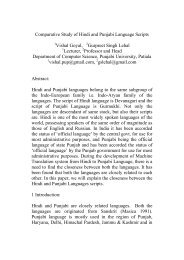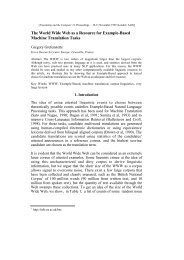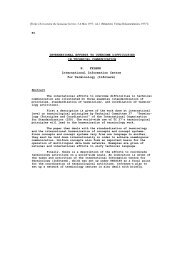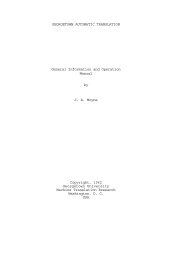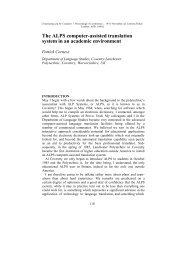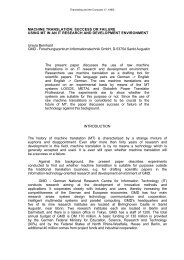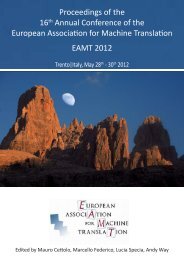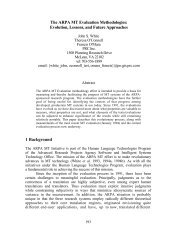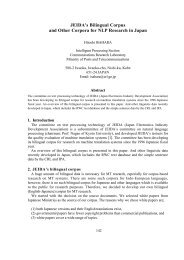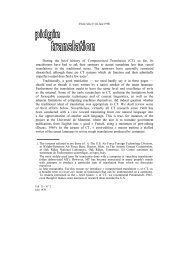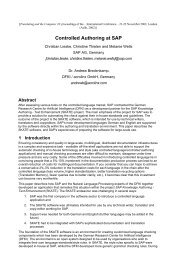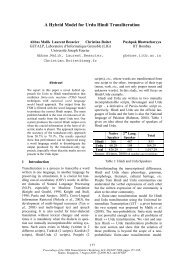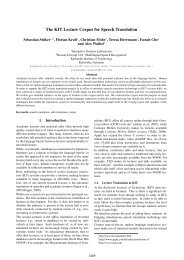Machine translation with inferred finite-state transducers
Machine translation with inferred finite-state transducers
Machine translation with inferred finite-state transducers
You also want an ePaper? Increase the reach of your titles
YUMPU automatically turns print PDFs into web optimized ePapers that Google loves.
Computational Linguistics Volume 30, Number 2<br />
214<br />
0<br />
(una , a)<br />
(la , the)<br />
1<br />
4<br />
(camera doppia , double room)<br />
(camera , room)<br />
(camera , room)<br />
(camera singola , single room)<br />
Figure 5<br />
Bigram model <strong>inferred</strong> from strings obtained by the transformation L2 in example 2.<br />
is estimated as<br />
pn(zi | zi−n+1 ...zi−1) = c(zi−n+1, ..., zi−1, zi)<br />
(12)<br />
c(zi−n+1, ..., zi−1)<br />
where c(·) is the number of times that an event occurs in the training set. To deal <strong>with</strong><br />
unseen n-grams, the back-off smoothing technique from the CMU Statistical Language<br />
Modeling (SLM) Toolkit (Rosenfeld 1995) has been used.<br />
The (smoothed) n-gram model obtained from the set of extended symbols is represented<br />
as a stochastic <strong>finite</strong>-<strong>state</strong> automaton (Llorens, Vilar, and Casacuberta 2002). The<br />
<strong>state</strong>s of the automaton are the observed (n − 1)-grams. For the n-gram (zi−n+1 ...zi),<br />
there is a transition from <strong>state</strong> (zi−n+1 ...zi−1) to <strong>state</strong> (zi−n+2 ...zi) <strong>with</strong> the associated<br />
extended word zi and a probability pn(zi | zi−n+1 ...zi−1). The back-off smoothing<br />
method supplied by the SLM Toolkit is represented by the <strong>state</strong>s corresponding to kgrams<br />
(k < n) and by special transitions between k-gram <strong>state</strong>s and (k − 1)-gram<br />
<strong>state</strong>s (Llorens, Vilar, and Casacuberta 2002). The final-<strong>state</strong> probability is computed<br />
as the probability of a transition <strong>with</strong> an end-of-sentence mark.<br />
4.4 Third Step of the GIATI Methodology: Transforming a Stochastic Regular Grammar<br />
into a Stochastic Finite-State Transducer<br />
In order to obtain a <strong>finite</strong>-<strong>state</strong> transducer from a grammar of L1–transformed symbols,<br />
an “inverse transformation” Λ(·) is used which is based on two simple morphisms:<br />
if (a, b1b2 ...bk) ∈ Γ <strong>with</strong> a ∈ Σ and b1, b2, ..., bk ∈ ∆,<br />
hΣ((a, b1b2 ...bk)) = a<br />
h∆((a, b1b2 ...bk)) = b1 b2 ...bk<br />
It can be verified that this constitutes a true inverse transformation; that is, for every<br />
training pair ∀(s, t) ∈ A<br />
s = hΣ(L1(s, t)), t = h∆(L1(s, t))<br />
If zi is a transition of the <strong>inferred</strong> regular grammar, where zi =(a, b1b2 ...bk) ∈ Γ, the<br />
corresponding transition of the resulting <strong>finite</strong>-<strong>state</strong> transducer is (q, a, b1b2 ···bk, q ′ ).<br />
This construction is illustrated in Figures 6 and 7 for the bigrams of Figures 4 and 5,<br />
respectively. Note that in the second case, this construction entails the trivial addition of<br />
a few <strong>state</strong>s which did not exist in the corresponding bigram. As previously discussed,<br />
the first transformation (L1) de<strong>finite</strong>ly leads to a greater <strong>translation</strong> generalization than<br />
the second (L2) (Casacuberta, Vidal, and Picó 2004). The probabilities associated <strong>with</strong><br />
2<br />
3<br />
5



